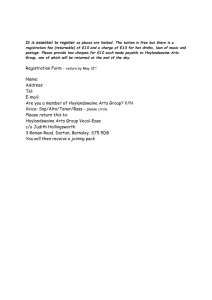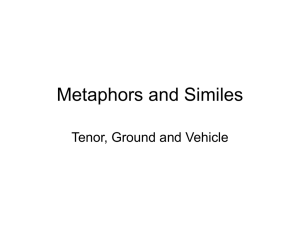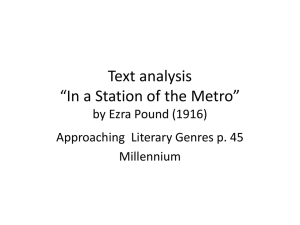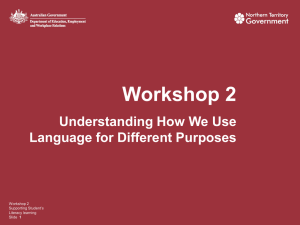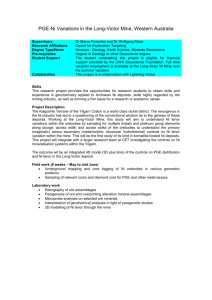Metaphors Assignment
advertisement
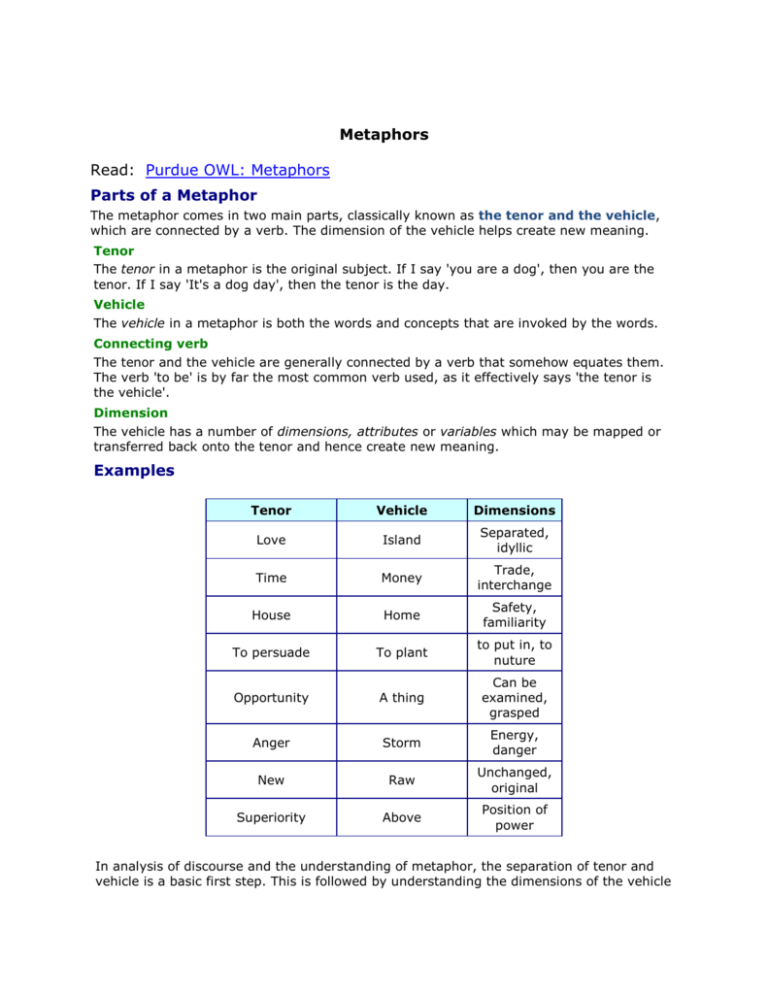
Metaphors Read: Purdue OWL: Metaphors Parts of a Metaphor The metaphor comes in two main parts, classically known as the tenor and the vehicle, which are connected by a verb. The dimension of the vehicle helps create new meaning. Tenor The tenor in a metaphor is the original subject. If I say 'you are a dog', then you are the tenor. If I say 'It's a dog day', then the tenor is the day. Vehicle The vehicle in a metaphor is both the words and concepts that are invoked by the words. Connecting verb The tenor and the vehicle are generally connected by a verb that somehow equates them. The verb 'to be' is by far the most common verb used, as it effectively says 'the tenor is the vehicle'. Dimension The vehicle has a number of dimensions, attributes or variables which may be mapped or transferred back onto the tenor and hence create new meaning. Examples Tenor Vehicle Dimensions Love Island Separated, idyllic Time Money Trade, interchange House Home Safety, familiarity To persuade To plant to put in, to nuture Opportunity A thing Can be examined, grasped Anger Storm Energy, danger New Raw Unchanged, original Superiority Above Position of power In analysis of discourse and the understanding of metaphor, the separation of tenor and vehicle is a basic first step. This is followed by understanding the dimensions of the vehicle and how these are mapped back onto the tenor and how meaning is changed or extended as a result. A good metaphor has many dimensions that map well into the tenor. A bad metaphor has dimensions that either do not map back to the tenor or, worse, create a distorted understanding. Implicit metaphor is a comparison between two unlike things in which the tenor is not specified, but is implied by the vehicle. For example: "The reed was too frail to survive the storm of its sorrows." Implicit tenor: a human Vehicle: reed Explicit tenor: sorrows Vehicle: storm Tenor Vehicle Dimension Human (implicit) reed Weak Sorrows (explicit) storm powerful Explication: The metaphor compares the vehicle, a "frail reed," to an implied tenor, a person whose "sorrows" are too much for her to endure. The image of a reed battered by the wind and rain of an unrelenting storm captures the hopeless emotions associated with human despair, depression, and desperation. Assignment: 1. Read Sylvia Plath’s “Cut” and Robert Frosts’ “Bereft” (see full texts in First Class and through links below). Analyze the metaphors in the following lines, using the “tenor, vehicle, dimension” chart illustrated above. Frost’s “Bereft”: Where had I heard this wind before Change like this to a deeper roar? What would it take my standing there for, Holding open a restive door, Looking down hill to a frothy shore? Summer was past and the day was past. Sombre clouds in the west were massed. Plath’s “Cut” What a thrill ---My thumb instead of an onion. The top quite gone Except for a sort of hinge Of skin, ……….. Out of a gap A million soldiers run, Redcoats, every one. 2. Write no more than three sentences (150 words) that fully explicate the lines through the metaphors, and, in relation to those, the images and symbols. 3. Write a one- page explication of “Cut,” or “Design” that leads with a thesis sentence that puts the main idea in the independent clause and the subordinate information in phrases or clauses. You will find copies of “Cut” and “Design” in First Class or you can access them through these links: “Design” by Robert Frost “The Cut” by Sylvia Plath
